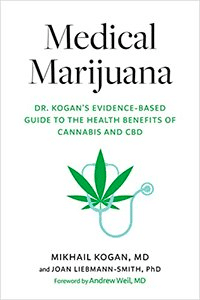Pain is the most common malady to afflict humankind and the major reason people seek medical care. The annual healthcare costs related to pain are over $300 billion, which is greater than the costs of heart disease, cancer, and diabetes combined. According to a landmark report by the National Academies of Sciences, Engineering, and Medicine, “There is conclusive or substantial evidence that cannabis or cannabinoids are effective for the treatment of chronic pain in adults.”

Cannabis products have been used since ancient times for such conditions as joint pain, migraine headaches, neuropathic pain, and even convulsions, to name but a few. And modern science backs up what our ancestors knew. The recently discovered endocannabinoid system (ECS) controls inflammation – a major source of pain – as well as pain from other causes. By activating certain receptors in the ECS, cannabis can help reduce pain and inflammation.
The FDA has approved two synthetic forms of THC – Marinol (dronabinol) and Cesamet (nabilone) – which are only available by prescription, usually in pill form. Both are approved for treatment of chemo-related nausea, and Marinol has been approved as an appetite stimulant for HIV patients but not cancer patients. Unfortunately, these drugs haven’t been very effective for treating chronic pain. Nor have they been very popular with patients.
Another pharmaceutical cannabinoid product, Sativex (nabiximols), is a natural, plant-derived tincture from cannabis that contains both THC and CBD, the nonintoxicating component of the cannabis plant. Although it’s been successfully used as an oral spray in England, Canada, and other countries for multiple sclerosis pain and spasticity, as well as neuropathic (nerve) pain, Sativex has not yet been approved for use in the United States.
Medical Marijuana for Pain
Recent surveys estimate that more than 90 percent of medical marijuana consumers have used it for pain relief. Chronic pain sufferers generally prefer the good old-fashioned natural cannabis flower to the more modern, man-made marijuana, according to a recent review article. And those who do use synthetic cannabinoids tend to quit using them because of their ineffectiveness and/or side effects.
Compared with Rx cannabinoid pills, inhaled and some other forms of marijuana are more desirable because they work more rapidly and have fewer side effects. And, according to the review article mentioned above, “Scientific evidence indicates that the inhaled (vaporized) option is more predictable, effective, and potentially tolerable than oral preparations.” That said there are some potential problems with vaping [which are discussed elsewhere in the book]. As with any drug, medical marijuana should be used with caution, ideally under the supervision of a physician or qualified healthcare provider.
All too often, chronic pain patients haven’t had the causes of their pain carefully assessed and treated. Before recommending medical cannabis, I often first refer pain patients to experts in manual medicine, including osteopathic doctors, physical therapists, and massage therapists. For countless patients, their pain is resolved and their physical functioning is restored as a result of these referrals. Additionally, mind/body techniques, especially the widely studied mindfulness-based stress reduction programs, have been proven very helpful for chronic pain.
Another very common problem I see with chronic pain is poor nutritional status and inflammation. I estimate that at least half, if not more, of all patients with chronic pain would benefit from magnesium and B complex even if they don’t have a deficiency. Once these core issues are addressed, if the pain persists, I then recommend cannabis. But the type and route of administration matter substantially.
CBD Alone Not as Effective
Unfortunately, there’s a large gap in knowledge about which cannabinoids, combinations, and ratios might work best for different kinds of pain. This is in part because there’s virtually no federal funding to support this kind of clinical research. Fortunately, some cannabis companies are starting to step in to conduct important research on the use of cannabis and CBD on pain patients.
Many patients swear by the beneficial effects of CBD alone for pain, but to date, there’s no clinical evidence to support this. While I’ve seen a number of patients who clearly have less pain after using CBD alone, the majority needed at least some added THC.
There is evidence that combining CBD with a common terpene, β-caryophyllene (BCP), can help relieve pain better than CBD alone. Terpenes not only add aroma and flavor to cannabis but can also boost its effectiveness – a phenomenon known as the entourage effect. BCP can also enhance cognition, improve digestion, and induce relaxation without sedation. BCP can be found in common spices, including cinnamon, oregano, clove, and black peppercorns.
Several less-known cannabis compounds, especially cannabidiolic acid (CBDA) and cannabigerol (CBG), have been found to be effective for chronic pain and other conditions in animal studies. Unfortunately, they have rarely been studied in humans and are not yet as widely available as THC or CBD. However, increasing numbers of clinicians have reported that their patients find them helpful for some types of chronic pain.
Cannabinoid Combinations
I find that CBDA can be very helpful for inflammatory types of pain; it’s now one of my standard tools for patients with inflammatory pain conditions such as rheumatoid arthritis. While some patients with these conditions may not achieve complete pain relief with CBDA alone, some have achieved complete or partial remission of their arthritis at high doses of 100 to 200 mg/day. I also find that CBDA combined with CBD can be especially helpful in older adults with osteoarthritis. I recommend 1:1 CBD:CBDA in an oral or sublingual dose starting at around 10 to 15 mg of CBD and CBDA twice daily, and, if needed, titrating up to as high as 50 to 100 mg of each twice daily.
I’ve also found that full-spectrum CBDA hemp oil in sublingual, oral, or topical form can be very effective for relieving muscle soreness from minor trauma or overexercise. I’ve recently seen increasing numbers of athletes who use CBD and CBDA for minor, post-exercise soreness and find it very helpful. That’s a welcome change, given that CBD and CBDA are safer in the long run than conventional medications such as Advil and Tylenol.
Adding CBG to other cannabinoids such as CBD and THC can help relieve osteoarthritis and neuropathic pain in some patients. CBG is also helpful for decreasing anxiety. However, it shouldn’t be taken at night because it can be rather stimulating and may interfere with sleep. For those patients who are sensitive to any amount of THC during the day, I find that using a combination of CBD, CBDA, and CBG in the morning can be very helpful for several types of pain, including neuropathic pain and inflammatory pain from osteoarthritis and other conditions. Similar to CBDA, the CBG dose is typically much lower than CBD, in the 5 to 10 mg range, taken once daily in the morning.
Finally, whatever your smallest effective dose is, that’s your best dose! “Stop when you get to where you need to go.” You’ll also save money.
Excerpted from Medical Marijuana: Dr. Kogan’s Evidence-Based Guideto the Health Benefits of Cannabis and CBD by Dr. Mikhail Kogan and Joan Liebmann-Smith.
Recommended Readings
Is “Pure” CBD Better?
A groundbreaking study has documented the superior therapeutic properties of whole plant CBD extract.
CBD & Cannabis for Pets in Pain
A veterinarian’s advice on how to use cannabis to treat pain in your pooch.



